Korfball drills
- Player A starts with the ball 2.5 meters diagonally in front of the post.
- Player B also stands 2.5 meters diagonally in front of the post.
- Player A throws the ball to player B and player B throws it back.
- Thus they bring the ball up to about 8 meters in front of the post.
- From there player B starts for a through ball from the space indicated by player A.
- Player A also runs in after it to catch the ball before it bounces on the ground.
Variations:
- Most goals in a 10-minute time frame.
- Whoever gets to 10 goals first.
- Make it harder by taking a point off every ball on the ground.
- Possibly with a 3rd person there to rotate through and keep a slightly slower pace.
- Most goals in a 10-minute time frame.
- Whoever gets to 10 goals first.
- Make it harder by taking a point off every ball on the ground.
- Possibly with a 3rd person there to rotate through and keep a slightly slower pace.
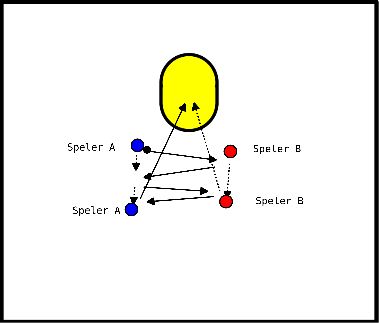
- Ball is played from the other box to the very high running support player.
- Just before the ball is received, it is run in from the side to the post.
- This player is played on and makes a through ball.
- The fourth player catches and plays the ball to the now run-through declarer.
- High support player runs to the other box, the passer becomes the new high support, the shooter catches and the player from the other box becomes the shooter.
Score 20 through balls from the right and 20 from the left.
Indicate with the outer hand, the other hand is bothered by the defender.
Indicate with the outer hand, the other hand is bothered by the defender.
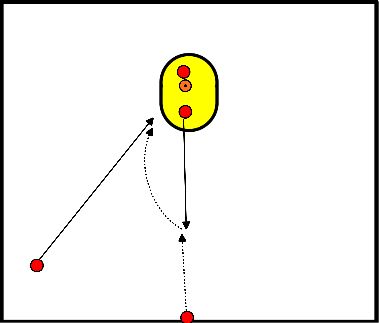
- Per person, everyone must score 10 through balls, this goes in groups of 3 or 4.
- In case of a miss, the whole group goes to the other side of the field on pace run and back.
- The one who missed takes the chance again.
- Until 10 are scored per player.
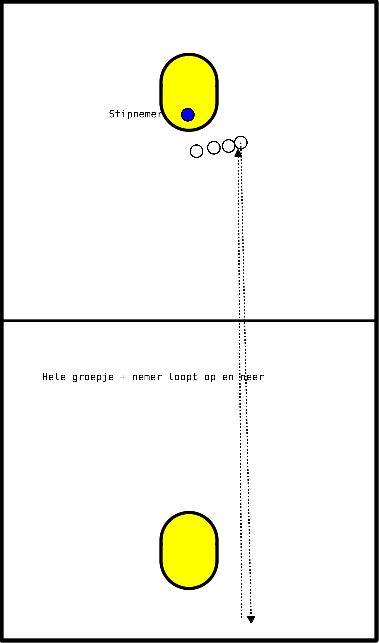
- White throws to blue and blue passes to red.
- Blue goes for the breakthrough and gets it to red.
- Blue shoots and catches himself. White goes to blue's position.
- Blue plays the ball to red, who passes to white, then breaks through and gets the ball from white.
- Blue and red switch positions and so on.
- 20x scoring.
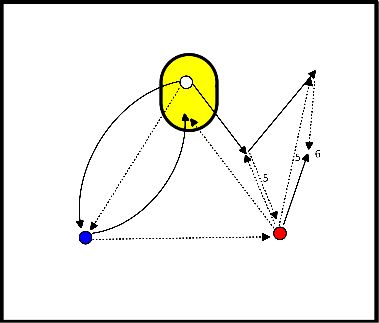
1.Sprint to the hat in front of you, place your foot next to it, make a turn and sprint to the next hat and so around the box. 4x
2. You keep looking in the same direction at all times. You sprint forward, then backward as fast as you can to the first hat.
Then sideways right and back and then sideways left and back. 3x
2. You keep looking in the same direction at all times. You sprint forward, then backward as fast as you can to the first hat.
Then sideways right and back and then sideways left and back. 3x
3. Forward to right, sideways to left and backwards to starting point. 2x clockwise and 2x counterclockwise.
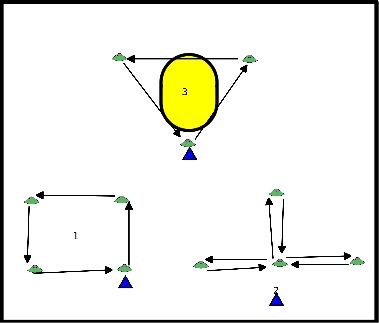
- For the example, I assume 6 / 7 players.
- On a line the length of the field there are 3 poles spaced about 7 meters apart.
- At each pole stands 1 player with ball.
- First the remaining players walk past all the posts and take a through ball everywhere.
- Repeat this 3 times and then switch positions.
- The next round are dodge balls to the left.
- The next round dodge balls to the right.
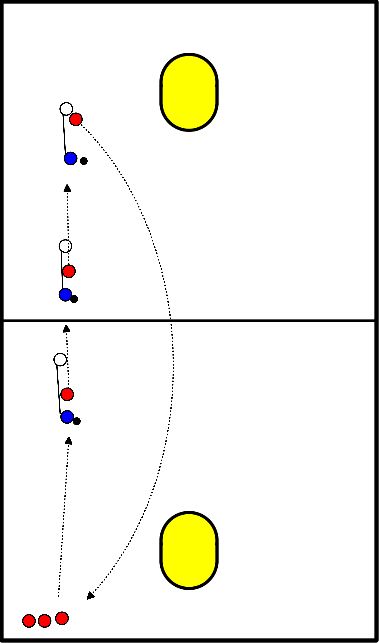
- Make 2 teams.
- Each team stands ready on one side of the field on the back line.
- Put as many balls as players on both the 3-meter lines.
- When the trainer/trainer calls GO!, everyone starts rolling the balls to the other side.
- Whoever has the fewest balls in their field after 3 minutes has won.
- At trainer's signal, both players start sprinting.
- Blue must run around first pawn and Red runs straight through to tap Blue.
- Red becomes Blue and flips over.
Objective:
The base is a standard running form exercise, where you have players move back and forth in different ways to train general motor skills.
The tap game element adds responsiveness by having players react as quickly as possible and determine what they are going to do.
The tap game element adds responsiveness by having players react as quickly as possible and determine what they are going to do.
Description:
- The players stand on a line and are given a way by the trainer to run across each time, see also running forms.
- All players have a ribbon on, 1-3 players with the same color.
Occasionally, while walking back and forth, the trainer calls out the color of 1 of the ribbons. These then become the tickers. The tickers get 10 seconds to tap as many of the remaining players as possible. - Then all return to the same line and start a running form again.
- The idea is to start the tagging round immediately when the trainer calls a color and to quickly start the next running form when the tagging round is over. Keep up the pace.
Variations:
Instead of running forms where players walk back and forth, you can do movement exercises standing in the same spot. Examples include Jumping Jacks, sitting/lying and getting up again, jumping forward and backward, etc.
The trainer occasionally gives the next movement assignment and calls a color to start a tap round.
Running Forms:
Standard
- Running / Running backwards
- Hopping / Hopping backwards
- Sideways with front right / Sideways with front left
- Small steps
- Hopping on right / Hopping on left
- Cross pass
Jumps
- Jumps as large as possible.
- Medium-sized jumps and always balancing on 1 foot for a while before taking the next jump.
- With two feet side by side.
- With two feet side by side a big jump forward and another small jump back.
- With two feet zigzagging.
Arm movements to be combined with the above forms.
- Swing 1 arm forward or backward.
- Swing both arms forward, or both backward.
- 1 arm forward and 1 arm backward.
- Holding another body part with 1 or both arms.
As animals
- Frog; jumping on hands and feet.
- Crab; on hands and feet, with belly up.
- Kangaroo; jumping on two legs.
- Flamingo; hopping.
- Duck; crouching walk.
The trainer occasionally gives the next movement assignment and calls a color to start a tap round.
Running Forms:
Standard
- Running / Running backwards
- Hopping / Hopping backwards
- Sideways with front right / Sideways with front left
- Small steps
- Hopping on right / Hopping on left
- Cross pass
Jumps
- Jumps as large as possible.
- Medium-sized jumps and always balancing on 1 foot for a while before taking the next jump.
- With two feet side by side.
- With two feet side by side a big jump forward and another small jump back.
- With two feet zigzagging.
Arm movements to be combined with the above forms.
- Swing 1 arm forward or backward.
- Swing both arms forward, or both backward.
- 1 arm forward and 1 arm backward.
- Holding another body part with 1 or both arms.
As animals
- Frog; jumping on hands and feet.
- Crab; on hands and feet, with belly up.
- Kangaroo; jumping on two legs.
- Flamingo; hopping.
- Duck; crouching walk.
- Indicate from space.
- Player walks to pilon and makes sideways move to left or right.
- Clearly makes 3 passes sideways facing the basket.
- Then follows a through ball.
- Defender follows and tries to give as much pressure as possible.
Goal: defend your own basket but score at another. Whoever remains last wins.
Minimum 3 groups of 2.
Maximum 5 groups of 3 or 4 groups of 4.
Minimum 3 groups of 2.
Maximum 5 groups of 3 or 4 groups of 4.
- Each group has a basket.
- Number of balls depends on how many groups. For example, 3 groups 2 balls.
- Make easier by fewer balls and larger groups.
- Three baskets in triangle, divide among the three baskets.
- Walk-through take, play out from basket 1 to basket 2, as player chases your ball for the walk-through.
- Player 1 leaves from basket 1 to basket 2. Player 2 throws from basket 1 the deep ball to player 1 who takes a follow-through.
- Make 20 with each other, then exchange throws with 'bad' hand.








